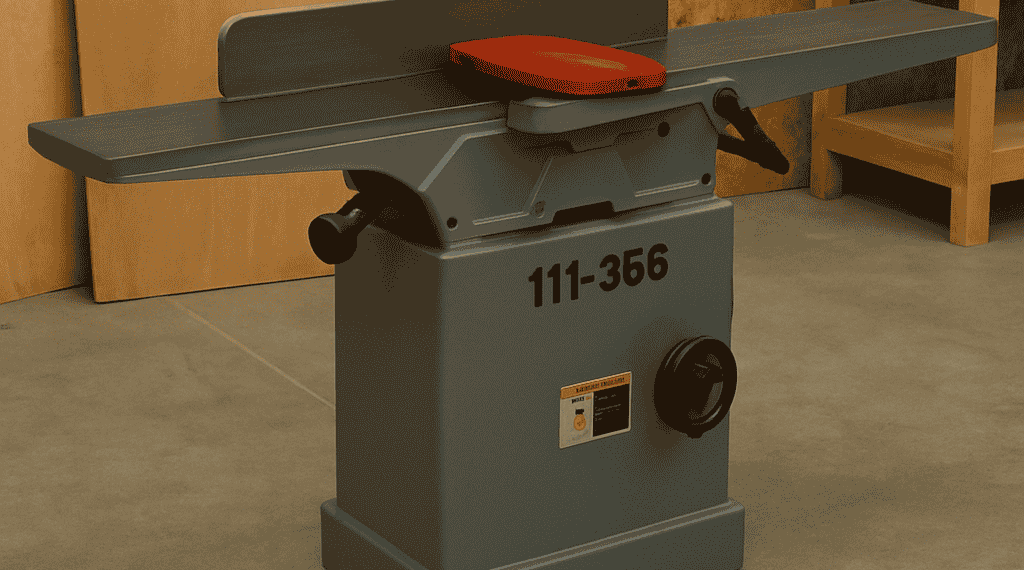When it comes to creating flawless edges and perfectly flat boards, a good jointer can make all the difference. The 111-356 jointer specs has earned a solid reputation among woodworking enthusiasts for its rugged performance, durable construction, and accurate results.
In this article, we’ll break down the 111-356 jointer specs, explain its strengths, and help you decide if it’s the right fit for your woodworking needs.
What Is the 111-356 Jointer?
The 111-356 jointer is a vintage woodworking machine, commonly attributed to Delta or Rockwell, two respected names in woodworking equipment. While no longer in current production, it remains a favorite among craftsmen who value solid cast-iron construction and precise cutting capabilities.
Whether you’re flattening rough stock or preparing edges for gluing, this jointer delivers consistent results, even after years of use.
Key 111-356 Jointer Specs (At a Glance)
Here’s a quick overview of the technical specifications:
| Feature | Details |
| Motor Power | 1 HP, typically 110/220V dual voltage |
| Cutterhead | 3-knife cutterhead, belt-driven |
| Cutterhead Speed | Approx. 4,500 – 6,000 RPM |
| Cutting Width | 6 inches |
| Cutting Depth | Up to 1/8 inch per pass |
| Table Length | Around 46 to 48 inches |
| Fence Size | Adjustable, tilts 45° left/right |
| Construction | Cast iron body and tables |
| Dust Collection Port | Not standard, can be added aftermarket |
| Weight | ~200+ lbs (varies slightly by model) |
These specifications put the 111-356 in the same category as heavy-duty 6-inch jointers, which are ideal for medium to large home workshops.
Performance That Holds Up Over Time
The 111-356 is known for its uncompromising performance. The powerful 1 HP motor handles hardwoods with ease, while the three-blade cutterhead ensures smooth, even cuts with minimal tear-out.
Even after decades of use, users report that this machine holds alignment well and delivers the same level of precision it did when it was new. That’s a testament to its solid design and build quality.
Transitioning from softwoods to hardwoods? No problem. This jointer handles both effortlessly.
Precision Where It Matters
Accuracy is crucial in woodworking. Fortunately, the 111-356 jointer specs excels in this area. The infeed and outfeed tables are long enough to support larger workpieces, which reduces snipe and keeps your edges straight.
The cast-iron fence is another strong point. It adjusts smoothly and locks securely, which helps maintain square joints. Plus, the tilt feature lets you easily create bevels when needed.
With proper tuning, the 111-356 is capable of producing furniture-grade joints every time.
Built to Last
One of the standout features of the 111-356 jointer is its durability. The heavy cast-iron construction provides excellent stability and vibration resistance, which improves safety and cut quality.
Unlike many modern machines made with aluminum or plastic components, this jointer was built during a time when durability came first. As a result, many 111-356 units from the 1960s and 70s are still in daily use.
Keep it clean, lubricate key components, and it will serve you for decades.
How It Compares to Other Jointers
If you’re comparing the 111-356 to newer benchtop models, here’s what you need to know:
| Feature | 111-356 Jointer | Modern Benchtop Jointers |
| Build Quality | Cast iron, heavy-duty | Lightweight, plastic/aluminum |
| Cutterhead | 3-knife | 2- or 3-knife (some helical) |
| Portability | Stationary | Portable |
| Motor Strength | Stronger and more stable | Less powerful |
| Cost (Used) | Affordable | Varies |
The 111-356 is a stationary tool, not a portable one. But if you have the space, its cutting performance is hard to beat.
Pros and Cons
Let’s take a quick look at the strengths and limitations:
✅ Pros
- Excellent build quality
- Precise and smooth cuts
- Stable and vibration-free
- Reliable motor and mechanics
❌ Cons
- Heavy and hard to move
- No built-in dust collection
- Requires careful setup for best results
Despite its age, the 111-356 still outperforms many newer machines in its class.
What Do Users Say?
Many woodworkers on forums and YouTube praise the 111-356 for its long-lasting performance. Some have used it for 20+ years with only minor maintenance.
Common user feedback includes:
- “Still cuts like a dream.”
- “Best investment I made for my shop.”
- “Tuning takes a little time, but it’s worth it.”
That kind of loyalty speaks volumes.
Buying Tips: Where to Find One
Since the 111-356 jointer is no longer in production, your best bet is the used market. Look at:
- eBay
- Craigslist
- Facebook Marketplace
- Local estate sales or auctions
Before buying, inspect the tables for flatness, ensure the cutterhead spins freely, and check for any motor issues.
You can often find them for $200–$400, depending on condition.
Maintenance Tips
Want your jointer to last? Follow these tips:
- Clean tables regularly to prevent rust.
- Keep the knives sharp or replace as needed.
- Lubricate moving parts.
- Check alignment and belt tension every few months.
A little maintenance goes a long way with this machine.
Final Verdict
The 111-356 jointer is a time-tested workhorse. It offers excellent performance, unmatched durability, and rock-solid precision. If you find one in good condition, don’t hesitate, it’s still one of the best jointers you can own.
Perfect for intermediate and advanced woodworkers, this jointer is a smart addition to any serious workshop.
FAQs
Q: What is the cutting width of the 111-356 jointer?
A: It offers a 6-inch cutting width, ideal for most edge jointing tasks.
Q: Can I still buy parts for the 111-356?
A: Yes, parts are often available on eBay or specialty woodworking sites.
Q: Is the 111-356 good for beginners?
A: Absolutely. With proper setup, it’s user-friendly and reliable.
Q: Does it support dust collection?
A: Not originally, but you can add an aftermarket port or hood.



